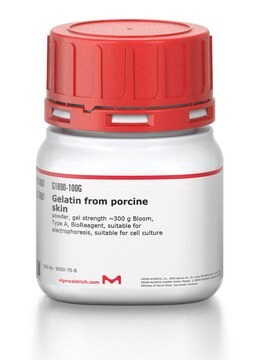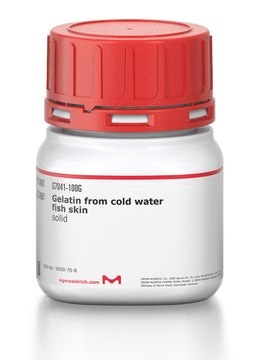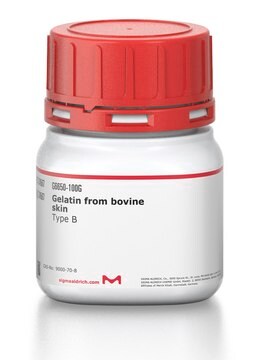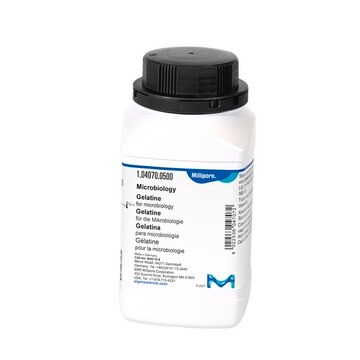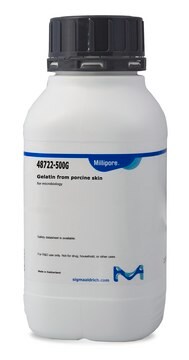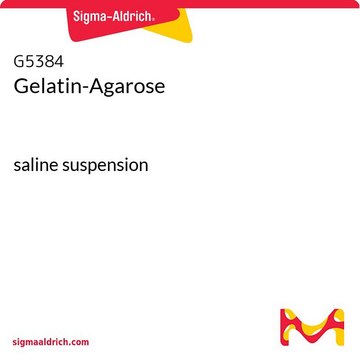G1393
Bovine Gelatin
from bovine hide, Type B, liquid, suitable for cell culture
About This Item
Recommended Products
product name
Gelatin solution, Type B, 2% in H2O, tissue culture grade, BioReagent, suitable for cell culture
biological source
bovine hide
Quality Level
sterility
sterile
type
Type B
product line
BioReagent
form
solution
packaging
pkg of 100 mL
pkg of 20 mL
concentration
2% in H2O, tissue culture grade
technique(s)
cell culture | mammalian: suitable
surface coverage
100‑200 μg/cm2
impurities
endotoxin, tested
solubility
water: soluble
Binding Specificity
Peptide Source: Fibrinogen
shipped in
ambient
storage temp.
2-8°C
Looking for similar products? Visit Product Comparison Guide
General description
Application
- for coating of cell culture plates or dishes used for embryonic stem cell culture, testicular cell culture and neural rosettes
- in coating cell culture to improve attachment of cells
- in PCR to stabilize Taq DNA
- as a blocking reagent in western blotting
- in ELISA
- in immunochemistry
- as a component of media for species differentiation in bacteriology
- to study long-chain fatty acid-induced changes in gene expression in neonatal cardiac monocytes
- to study to test mobilization of capillary endothelium in vitro induced by effectors of angiogenesis in vivo
Biochem/physiol Actions
Caution
Preparation Note
Storage Class Code
10 - Combustible liquids
WGK
WGK 2
Flash Point(F)
Not applicable
Flash Point(C)
Not applicable
Regulatory Listings
Regulatory Listings are mainly provided for chemical products. Only limited information can be provided here for non-chemical products. No entry means none of the components are listed. It is the user’s obligation to ensure the safe and legal use of the product.
JAN Code
G1393-100ML:
G1393-20ML-PW:
G1393-PH-X:
G1393-BULK:
G1393-VAR:
G1393-20ML:
G1393-100ML-PW:
G1393-PROC:
G1393PROC:
G1393-VAR-X:
G1393-BULK-X:
G1393-EW:
G1393-100ML-EW:
Certificates of Analysis (COA)
Search for Certificates of Analysis (COA) by entering the products Lot/Batch Number. Lot and Batch Numbers can be found on a product’s label following the words ‘Lot’ or ‘Batch’.
Already Own This Product?
Find documentation for the products that you have recently purchased in the Document Library.
Customers Also Viewed
Articles
Attachment Factors for 3-Dimensional Cell Culture
The extracellular matrix (ECM) is secreted by cells and surrounds them in tissues.
3D cell culture overview. Learn about 2D vs 3D cell culture, advantages of 3D cell culture, and techniques available to develop 3D cell models
Cancer stem cell media, spheroid plates and cancer stem cell markers to culture and characterize CSC populations.
Our team of scientists has experience in all areas of research including Life Science, Material Science, Chemical Synthesis, Chromatography, Analytical and many others.
Contact Technical Service